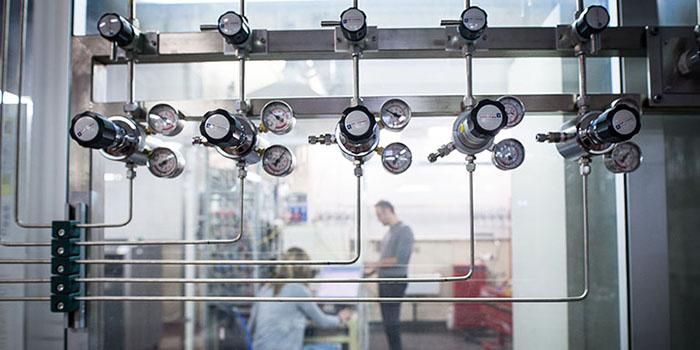
Gases stored in cylinders or passing through supply lines from cylinder boxes to laboratory outlets, at a pressure higher than atmospheric, can be divided into three types: inert, toxic, and flammable or combustible.
Inert gases (such as nitrogen, argon, and helium) are non-toxic gases that do not support human respiration and that react minimally or not at all with other substances. If an inert gas contained in a cylinder were accidentally released into the atmosphere, it would dilute the existing oxygen percentage. Under normal conditions, the volume concentration of oxygen in air is about 21%. The Occupational Safety and Health Administration (OSHA) defines threshold values for classifying a workplace as safe, with an oxygen concentration between 19.5% and 23%. The risk to be assessed and prevented is therefore that of over- or under-oxygenation. If, in the laboratory in question, inert gases are present, the risk of suffocation due to oxygen deficiency in the air must be considered, and oxygen detectors should be installed near potential gas leak points.
Toxic gases in case of inhalation can be lethal or cause acute or chronic injuries. For each substance, there are maximum allowable concentration values indicated by regulations, which specify the levels to which an individual can be exposed for a certain period of time without causing harm. If there is a risk of harmful effects to people due to these gases, it is necessary to have gas concentration detectors placed near potential gas leak points.
Flammable or combustible gases are gases that, when mixed with air (that is, with the oxygen that constitutes it) in certain proportions, create an explosive atmosphere. Each flammable gas is characterized by a lower explosive limit ('LEL'), which is the concentration of the gas in air below which an explosive atmosphere does not form due to the presence of the gas. In laboratories where explosive atmospheres could potentially form, it is advisable to place sensors near accidental release points so that the gas flow from the cylinder is blocked if the sensors detect a gas concentration close to its LEL.
Attention: Toxic and explosive gas cylinders (such as acetylene) cannot be stored in the laboratory. Flammable and oxidizer (oxygen) gas cylinders may be present but only contained in appropriate cabinets.
For more details on cylinders and gas supply lines in laboratories, please refer to the Gas Management Guide and the Cylinder Management Guide.